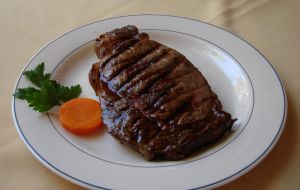MercoPress. South Atlantic News Agency
What about tasting some ‘Charlem’, Charleston engineered meat?
 US biologist and tissue engineer, Vladimir Mironov: bye, bye to cows
US biologist and tissue engineer, Vladimir Mironov: bye, bye to cows Vladimir Mironov, a US biologist and tissue engineer at the Medical University of South Carolina, has been working to grow “cultured” meat for a decade, and is closer than ever to achieving his goal.
It's a product he believes could help solve future global food crises resulting from shrinking amounts of land available for growing meat the old-fashioned way ... on the hoof.
Growth of “in-vitro” or cultured meat is also under way in the Netherlands, Mironov revealed but in the United States, it is science in search of funding and demand.
The new National Institute of Food and Agriculture, part of the US Food and Drug Administration, won't fund it, the National Institutes of Health won't fund it, and the National Aeronautics and Space Administration funded it only briefly, Mironov said.
Director of the Advanced Tissue Biofabrication Center in the Department of Regenerative Medicine and Cell Biology at the medical university, Mironov now primarily conducts research on tissue engineering, or growing, of human organs.
“There's a ‘yuck’ factor when people find out meat is grown in a lab. They don't like to associate technology with food,” said Nicholas Genovese, 32, a visiting scholar in cancer cell biology working under a People for the Ethical Treatment of Animals three-year grant to run Dr. Mironov's meat-growing lab.
“But there are a lot of products that we eat today that are considered natural that are produced in a similar manner,” Genovese said.
“There's yogurt, which is cultured yeast. You have wine production and beer production. These were not produced in laboratories. Society has accepted these products.”
If wine is produced in winery, beer in a brewery and bread in a bakery, where are you going to grow cultured meat? In a “carnery,” if Mironov has his way. That is the name he has given future production facilities.
He envisions football field-sized buildings filled with large bioreactors, or bioreactors the size of a coffee machine in grocery stores, to manufacture what he calls “charlem”, “Charleston engineered meat.”
“It will be functional, natural, designed food,” Mironov said. “How do you want it to taste? You want a little bit of fat, you want pork, and you want lamb? We design exactly what you want. We can design texture.
”I believe we can do it without genes. But there is no evidence that if you add genes the quality of food will somehow suffer. Genetically modified food is already normal practice and nobody dies.“
Cultured meat could eventually become cheaper than what Genovese called the heavily subsidized production of farm meat, he said, and if the public accepts cultured meat, the future holds benefits.
”Thirty percent of the earth's land surface area is associated with producing animal protein on farms,“ Genovese said.
”Animals require between 3 and 8 pounds of nutrient to make 1 pound of meat. It's fairly inefficient. Animals consume food and produce waste. Cultured meat doesn't have a digestive system. ”Further out, if we have interplanetary exploration, people will need to produce food in space and you can't take a cow with you”.





Top Comments
Disclaimer & comment rules-

-

Read all commentsThis is sick. This guy dreams to become the new Monsanto for meat.
Feb 16th, 2011 - 02:12 am 0Food crisis? Nonsenses. Get rid of the greedy bankers who kill us with speculation in commodities, and we'll be fine. There is no food crisis.
a biologist or a mass murderer?
Feb 17th, 2011 - 12:37 am 0Commenting for this story is now closed.
If you have a Facebook account, become a fan and comment on our Facebook Page!